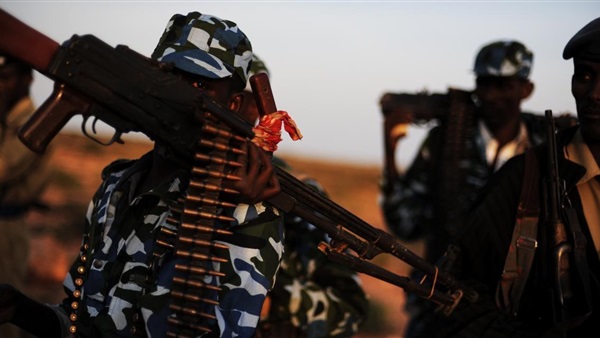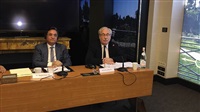African terrorist groups opt for mergers to escape international pressure

Developments on the ground and conflicts between the leaders of terrorist groups in the African continent are opening the door for the formation of new alliances and mergers.
The
northern part of Mali witnessed the formation of the latest of these alliances
with four militant groups forming what came to be known as "Islam and
Muslims Support Coalition".
The
new entity was announced in a video that was published in March last year. A
number of jihadist figures appeared in the video, including Iyad Ag Ghali, the
leader of Ansar al-Din; Jamal Okasha, the leader of the al-Qaeda-affiliated Desert
Front; Mohamed Kouffa, the leader of the Macina Liberation Front, and al-Hassan
al-Ansari, a leader of al-Mourabitoun group which is affiliated to Mukhtar
Belmukhtar.
The
new alliance declared in a statement that it would carry out operations in the
Sahel and Sahara region. This revealed al-Qaeda's plans to expand its presence
in this area in order to reduce some of the pressure put on it as a result of
the international war now being waged against it. Al-Qaeda also apparently
wants to prove that it is still strong in the face of all these attacks and
also to prove that it is stronger than Daesh which is followed by more
terrorist groups.
The
new alliance was formed a short time after five states, namely Mali,
Mauritania, Niger, Chad and Burkina Faso created a new counterterrorism force
in the region. It also coincided with attempts by France to strengthen its
presence in the border area between Mali and Niger, especially after a marked rise
in terrorist attacks there, the latest of which was on February 24, 2017 when a
group of militants attacked a border patrol and killed 15 troops.
The
formation of the new alliance shows that it is yet a new arm of al-Qaeda in the
area. Ghali, who was announced the leader of the new alliance, swore allegiance
to the al-Qaeda leader Ayman al-Zawahiri as well as to the al-Qaeda in the Arab
Maghreb which is lead by Abu Musab Abdel Wadoud.
Two
days after its formation, specifically on March 5, 2017, the new alliance
staged an attack against a Malian army post. The attack left 11 troops dead and
five others injured. On March 29, the alliance claimed responsibility for
another attack. On April 5, the same group killed a French soldier. On May 18,
alliance militants clashed with the Malian army and killed five army troops and
injured 20 others. Sixteen militants were also killed and four others were
taken hostage. On July 18, the same group claimed responsibility for an attack on
Malian capital Bamako. The attack left eight people dead, including four
civilians.
French
intelligence estimates the number of militants within the new alliance at 500.
Nonetheless, links between the alliance and al-Qaeda make it capable of
attracting recruits and staging attacks, even outside Mali's borders.
This
was quite evident in an attack the group staged on March 2, 2017 on the office
of the chief of staff of the Burkinabe army and the French embassy in
Ouagadougou, the capital of Burkina Faso. The attack left eight people dead and
12 others seriously injured, according to official reports.
The
alliance said in a statement that it staged the attack to avenge the killing of
dozens of its members in northern Mali two weeks earlier.
In
July 2017, the same group kidnapped six Westerners. In October of the same
year, the group posted a video in which it showed 11 Malian army troops it
claimed to have kidnapped earlier. On February 23, 2018, the group claimed
responsibility for cyber attacks against two Mauritanian sites.
Challenges
Despite
the ostensible strength of the new alliance, the merger of the groups making
this alliance is full of problems. One of the problems facing the merger is the
desire of each of the groups making it to have its own sphere of influence. Some
of the groups making the alliance outnumber others. Ansar al-Din, for example,
contributes the largest number of fighters to the alliance. The same militant
group has support from tribes in northern Mali. This strikes a discordant note
with the militant group al-Mourabitoun, another member of the alliance.
Al-Mourabitoun believes that it has more experience in combat than Ansar al-Din
has. Ghali, for his part, works to strengthen his grip on the new alliance,
which portends conflicts with other leaders in the alliance, including Abdel
Wadoud
Another
problem facing the new alliance is the presence of divergence when it comes to
the visions of each of its leaders. Muktar Belmukhtar, for example, adopts a
flexible policy toward other jihadist groups. His organization, al-Mourabitoun,
and the Great Desert Emirate adopt al-Qaeda's cross-border ideology. Ansar
al-Din, for its part, gives priority to action at the local level in the hope
of establishing an Islamic state in northern Mali.
This
is a new episode in the mergers between terrorists. But this will not be the
last one as a result of the crackdown by the international community on
terrorist organizations. There is also heated rivalry between groups affiliated
to al-Qaeda and others affiliated to Daesh. This makes mergers an important
mechanism for groups loyal to each of these two major terrorist organizations
on the road to more strength.









